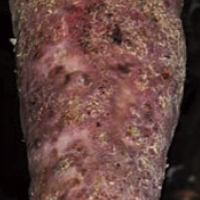Chromoblastomycosis evolving to sarcomatoid squamous cell carcinoma: A case report

Accepted: 16 December 2020
HTML: 59
All claims expressed in this article are solely those of the authors and do not necessarily represent those of their affiliated organizations, or those of the publisher, the editors and the reviewers. Any product that may be evaluated in this article or claim that may be made by its manufacturer is not guaranteed or endorsed by the publisher.
Chromoblastomycosis (CMB) is a cutaneous fungal infection caused by dematiaceous fungi. According to the World Health Organization CMB has been elected as a tropical disease, and it is prevalent in tropical and subtropical regions. The lower extremities are the most affected areas, and the lesions progress with erythema, papules, nodules, verrucose plates and/or ulcerations. So far, few works have demonstrated neoplastic transformation in chronic CMB lesions, and it may be a consequence of prolonged inflammatory response. In the present case report, we described a neoplastic transformation from CMB lesion of a 55- year-old man, presenting lesions only in the left leg for 35 years. After treatment, a verrucous white plate with thick and irregular borders emerged in the ankle, which was identified as a sarcomatoid squamous cell carcinoma. The present case report highlights the importance of an early diagnosis and treatment.
PAGEPress has chosen to apply the Creative Commons Attribution NonCommercial 4.0 International License (CC BY-NC 4.0) to all manuscripts to be published.





 https://doi.org/10.4081/dr.2021.9009
https://doi.org/10.4081/dr.2021.9009



